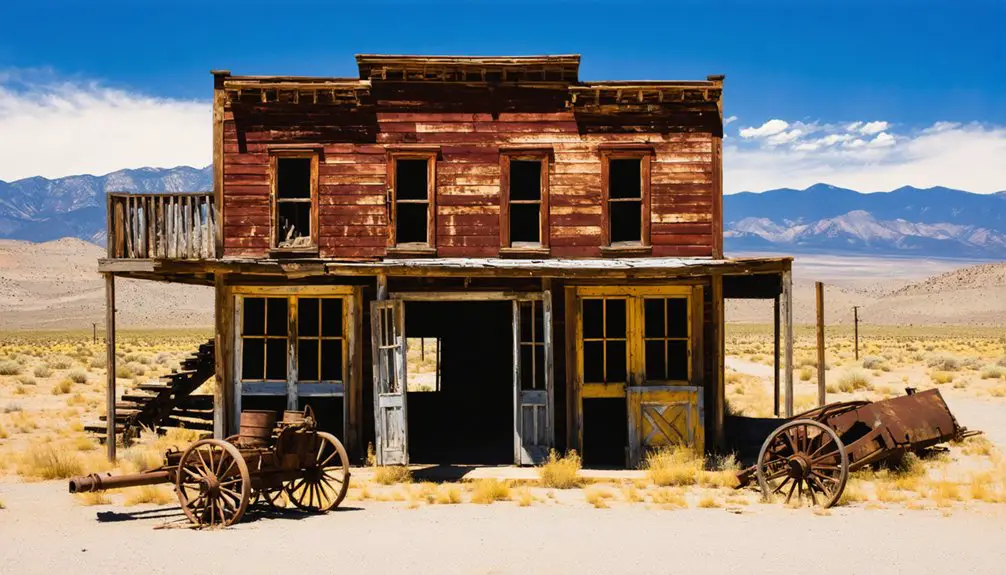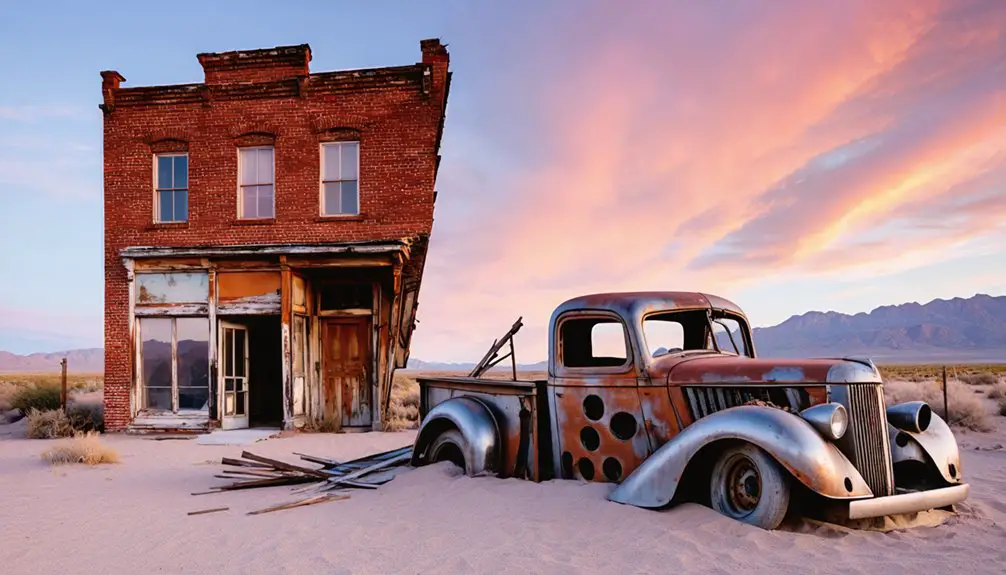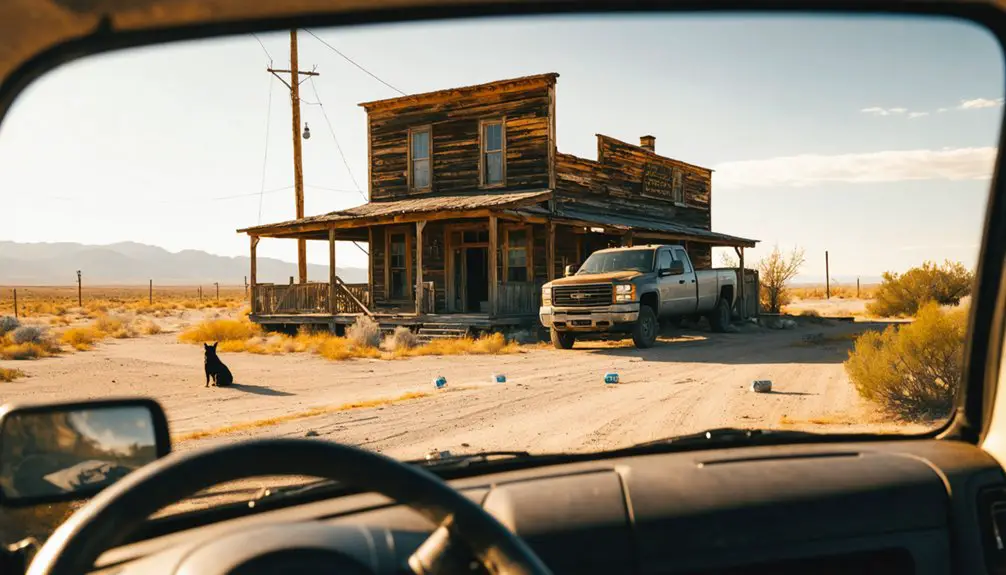You’ll find Tuscarora’s historic remains 50 miles northwest of Elko, Nevada, where gold and silver discoveries sparked a mining boom in 1867. This once-bustling town of 3,000 residents now preserves its mining legacy through architectural remnants, including an adobe fort and Masonic lodge. Chinese miners played an essential role, introducing innovative placer mining techniques that yielded up to $15 per day. Today, about 130 residents maintain an artistic community centered around the pottery school, with the town’s rich past echoing through its preserved structures.
Key Takeaways
- Tuscarora began as a gold mining town in 1867 and later boomed with silver discoveries, reaching a peak population of 3,000 residents.
- Chinese miners played a crucial role, introducing effective placer mining techniques and establishing a thriving cultural community in the 1870s.
- The town declined after 1895 when ore deposits depleted, with large-scale mining operations ending by 1917.
- Today, Tuscarora maintains a small population of about 130 residents and functions as an artists’ community with galleries and pottery school.
- Historic structures remain, including an 1867 adobe fort and operational post office, preserving the town’s mining-era heritage.
The Gold Discovery That Started It All
While various prospectors had searched Nevada’s mineral-rich landscape, it wasn’t until 1867 that brothers Steve and John Beard made the pivotal gold discovery in what would become the Tuscarora district.
With the help of a local native, they found placer gold near McCann Creek at 6,200 feet elevation in the Goose Creek Range, establishing a camp two miles south of present-day Tuscarora.
The initial gold prospecting proved lucrative, with miners averaging $12 per day working the placers on Beard Hill. The district would ultimately yield a total production of 6.345 tonnes of gold between 1867 and 1990.
When the transcontinental railroad’s completion in 1869 displaced Chinese laborers, they brought their mining techniques to Tuscarora, efficiently working the placer tailings.
By 1884, the skilled Chinese miners had extracted an impressive one million dollars from the abandoned placer deposits.
This early period of surface gold extraction lasted until 1871, when the district’s focus dramatically shifted to silver mining.
Life During the Silver Mining Boom
As silver discoveries transformed Tuscarora from a modest placer mining camp into a bustling boomtown in 1871, the population swelled to over 3,000 residents during its peak years of 1872-1884.
You’d find yourself amid fascinating cultural interactions between American miners and the second-largest Chinese community in the Western United States.
The town’s economic diversification went far beyond mining – you could visit Chinese-operated tea shops, silk merchants, and vegetable farms, or frequent the gambling houses and brothels that dotted the streets.
While hardrock miners worked the silver deposits, others supplemented their income through seasonal ranching in Independence Valley.
The town’s sophistication grew to include dancing academies and even a private elocution school, offering diversions uncommon in typical mining camps.
The brick and stone buildings dotted the landscape, showcasing the town’s prosperity and permanent nature.
The mines generated an impressive ten to forty million dollars in silver and gold production during the boom period.
Chinese Influence and Cultural Heritage
As you explore Tuscarora’s mining heritage, you’ll find that Chinese miners dominated the local population by 1870, representing 104 of the town’s 119 residents.
Their extensive placer mining operations, particularly at the Old Town site, generated between $700,000 to $7 million worth of gold in just two years, while establishing a self-sufficient community with its own assayers and cultural institutions.
The Chinese miners’ influence extended beyond gold extraction, as they contributed to borax mining and infrastructure development, while maintaining relatively harmonious relationships with both Native American and Euro-American settlers. The area’s development paralleled similar patterns seen with Native American tribes who had established significant settlements throughout Nevada and neighboring regions. By 1880, the Chinese community had become so well-established that they employed two Chinese assayers who played crucial roles in the mining operations.
Chinese Mining Practices
When Chinese miners arrived in Tuscarora around 1867, they brought distinctive placer mining techniques that would shape the region’s early gold production.
You’ll find their resourceful methods were particularly effective at the Beard discovery site, later known as Old Town, where they extracted gold from stream sediments that others had overlooked.
Many of these miners were former Central Pacific Railroad workers who applied their proven teamwork skills to mining operations.
Their communal labor model and efficient practices led to impressive yields, earning up to $15 per day during peak periods.
They contributed greatly to Tuscarora’s early boom, generating between $700,000 and $7 million in gold around 1869-1870.
Community Life and Culture
The cultural fabric of Tuscarora took shape through its dominant Chinese population, which by 1870 comprised 104 of the town’s 119 residents. Despite facing severe discrimination and social segregation, Chinese residents maintained vibrant traditions within their own enclave.
You’ll find evidence of their cultural resilience through archaeological artifacts that reveal distinct Chinese heritage in the mining town.
Community gatherings and cultural festivals provided essential connections for Chinese residents, who established their own merchants, doctors, priests, and teachers.
These cultural institutions helped preserve traditional customs in the frontier environment, particularly important given the isolation enforced by discriminatory laws like the 1875 Page Law.
While restricted from many professions and forced into labor-intensive roles, Chinese residents created internally cohesive cultural spaces that sustained their identity against considerable odds. Most Chinese immigrants viewed themselves as temporary sojourners seeking wealth before returning to their homeland.
Legacy Through The Ages
Throughout Tuscarora’s mining history, Chinese immigrants left an indelible mark that transformed Nevada’s cultural landscape and mining industry. You’ll find evidence of their cultural resilience in the town’s peak years, when Chinese miners made up nearly 90% of the population and contributed between $700,000 and $7 million in mineral production.
Their economic adaptation shaped Tuscarora’s development, establishing transpacific trade routes through San Francisco’s Bank of Canton to South China.
While the mines declined by 1895, the Chinese influence persisted through their entrepreneurial spirit, with two Chinese assayers operating as late as 1880.
Today, though mining operations have resumed, you can still trace the legacy of these pioneering Chinese miners who helped build Tuscarora’s reputation as a significant mining district while fostering harmonious relationships with both Native Americans and Euro-American settlers.
The Rise and Fall of a Mining Empire

You’ll find that Tuscarora’s meteoric rise as a mining empire began in 1867 with gold placer discoveries, leading to a remarkable boom period from 1872 to 1884 that generated between $10 million to $40 million in combined silver and gold revenue.
The district’s prosperity peaked with a population exceeding 3,000 residents, fueled by extraordinary silver ore yields from Mount Blitzen that assayed at $600 silver and $60 gold per ton.
Chinese miners dominated the local mining scene after taking over operations in 1869, with each worker earning between two to fifteen dollars per day through their placer mining efforts.
Mining Boom Years
After gold was discovered by the Beard brothers in 1867, Tuscarora rapidly transformed from a modest placer mining operation into one of Nevada’s most significant silver districts.
You’ll find that the turning point came in 1871 when W.O. Weed struck rich silver lodes at Mount Blitzen, yielding an impressive $600 in silver and $60 in gold per ton. Despite early mining techniques focusing on placer gold extraction, the district’s economic challenges shifted when silver became the primary target.
Between 1872 and 1884, you’d have witnessed Tuscarora’s explosive growth as it produced between $10-40 million in precious metals. The town was named after a gunboat that honored a North Carolina indigenous tribe.
The town expanded to house 3,000 residents, including a thriving Chinese community that mastered placer mining operations. Six mills with 80 stamps processed the abundant ore, while new toll roads connected the booming district to crucial railroad hubs.
Decline After 1917
While Tuscarora’s silver district had generated millions in precious metals during its heyday, by 1895 the annual mining production plummeted below $50,000 as rich ore veins became depleted.
You’d have witnessed a dramatic population decline as miners abandoned their claims, with the town’s peak population of over 3,000 dwindling to just a handful of residents by the late 20th century.
The mining camp’s infrastructure deterioration became evident as toll roads and freight routes lost significance.
Local newspaper suspended publication in 1908 as residents continued departing for new mining strikes.
Once-bustling stagecoach routes connecting Tuscarora to key railheads in Elko, Carlin, and Winnemucca fell silent.
By 1917, mining equipment was sold for scrap, marking the end of large-scale operations.
The few remaining inhabitants turned to ranching in Independence Valley, while the once-thriving Chinese community dispersed.
This dormant period lasted until 1987, when modern mining firms briefly revived operations.
Architectural Remnants and Historic Sites
Scattered across Tuscarora’s sloping terrain, numerous architectural remnants offer tangible connections to Nevada’s mining era.
You’ll find an 1867 adobe fort, evidence of the region’s complex settler-Native American relations, alongside crumbling brick chimneys and weathered homesteads. The town’s architectural preservation efforts focus on the historic boarding house and Masonic lodge, while original foundations peek through natural overgrowth. The operational post office maintains a living link to this ghost town’s past.
- The prominent hilltop chimney serves as both landmark and viewpoint over the valley
- Chinese miners’ presence is reflected in discovered artifacts and cemetery records
- Original street grid layout remains visible, revealing historic urban planning
- Mining infrastructure includes visible shaft entrances and mill remnants
- Historic water ditches demonstrate early utility development
Modern Art in an Ancient Setting

Despite its ghost town status, Tuscarora has evolved into a vibrant artistic hub where contemporary creators breathe new life into historic spaces.
You’ll find artists like Ron Arthaud, who’s been capturing the town’s decaying landscapes in plein air paintings since the 1990s, his work now featured in notable Nevada collections.
The artistic transformation of Tuscarora extends through its converted saloon-turned-gallery, where potters and visual artists showcase their creative exploration of mortality, time, and nature.
In this unique setting, you’ll discover how artists integrate local materials and ghost town remnants into their work, creating multilayered meanings that connect past to present.
The community’s emphasis on creative experimentation manifests in exhibitions featuring abstract interpretations of roads, journeys, and the harsh desert landscape that surrounds them.
Natural Beauty and Scenic Surroundings
Nestled on Mount Blitzen’s eastern slope in Nevada’s Tuscarora Mountains, this ghost town offers visitors a stunning backdrop of diverse terrain and natural wonders.
You’ll discover natural landscapes ranging from rugged mountain ridges to riparian creek beds, where native flora flourishes among historic mining remnants. The scenic vistas stretch across the Independence Valley, offering unobstructed views of the Great Basin’s vastness.
- Hike the mountain trails to photograph towering ore processing chimneys against panoramic backgrounds
- Explore McCann Creek’s banks, rich with desert-adapted vegetation and wildlife
- Witness seasonal wildflower blooms transforming the landscape during warmer months
- Study the varied microclimates created by elevation changes and terrain features
- Experience the interplay between historic ruins and native sagebrush, juniper, and pinyon pines
Daily Life in Present-Day Tuscarora

Although often labeled a ghost town, Tuscarora maintains a vibrant community of roughly 130 residents who’ve adapted modern life to their historic surroundings.
You’ll find daily routines centered around the town’s active post office, two schools, and the local bar and grill that serves as a hub for community gatherings.
The internationally renowned Tuscarora Pottery School stands as the cultural cornerstone, where local traditions blend with contemporary artistry.
You can experience the town’s unique character through pottery classes and art events that bring together residents and visitors.
Despite the extremely low population density of 0.13 persons per square mile, you’ll discover a close-knit community that preserves its mining heritage while embracing modern amenities.
Families here average over four members, contributing to the town’s sustained significance and social fabric.
Mining Legacy and Economic Impact
The discovery of placer gold by John and Steve Beard in 1867 launched Tuscarora’s remarkable mining saga, setting the stage for the town’s explosive growth and economic significance.
Mining techniques evolved from simple placer operations to sophisticated silver lode extraction, generating up to $40 million during the initial boom.
You’ll find evidence of diverse mining methods that supported economic sustainability through the 1880s, including Chinese placer mining innovations that yielded over $1 million in gold.
- Peak production reached 204,000 ounces of gold and 7.6 million ounces of silver
- Infrastructure development included toll roads connecting to major railheads
- Auxiliary industries emerged, including ranching and milling operations
- Chinese miners developed specialized placer mining techniques
- Economic impact extended beyond mining through trade and agriculture
Frequently Asked Questions
What Was the Average Wage of Miners During Tuscarora’s Peak Years?
You’d find mining wages varied considerably, from $12/day for early placer miners to potentially higher rates during the silver boom, with the economic impact driving peak earnings between 1872-1884.
How Did Residents Handle Medical Emergencies in This Remote Mining Town?
You’d rely on makeshift medical supplies and community knowledge, with miners sharing basic emergency training. Self-taught healers and Chinese herbalists provided care, while severe cases required long journeys to distant hospitals.
Were There Any Notable Crimes or Lawless Incidents During the Boom?
Like many frontier boomtowns, you’d find crime wasn’t well documented. While law enforcement was limited and vice activities flourished in gambling houses and opium dens, specific major criminal incidents weren’t officially recorded.
What Forms of Entertainment and Recreation Were Available to Early Settlers?
You’d find entertainment at saloons, dancing academies, pottery workshops, and community events. Social gatherings happened at boarding houses, while outdoor activities included hiking Mt. Blitzen and exploring mining ruins.
How Did Harsh Nevada Winters Affect Mining Operations and Daily Life?
You’ll find harsh conditions shut down mines, froze water supplies, and blocked supply routes. Winter survival meant stockpiling provisions, burning more fuel, and adapting work schedules to nature’s unforgiving rhythm.
References
- https://nevadamagazine.com/issue/spring-2024/23569/
- https://en.wikipedia.org/wiki/Tuscarora
- https://travelnevada.com/historical-interests/tuscarora/
- https://westernmininghistory.com/towns/nevada/tuscarora/
- https://forgottennevada.org/sites/tuscarora.html
- https://www.historynet.com/ghost-town-tuscarora-nevada/
- https://portergeo.com.au/database/mineinfo.asp?mineid=mn1660
- https://nbmg.unr.edu/staff/henry/castorettuscaroraecongeol2003.pdf
- https://shpo.nv.gov/nevadas-historical-markers/historical-markers/tuscarora
- http://www.onv-dev.duffion.com/articles/chinese-and-mining



